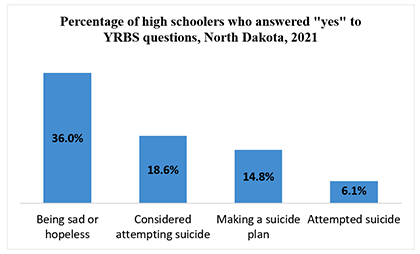Ask A Researcher
May 2024
Exploring Suicide Rates Among Youth
Iyobosa Sonia Omoregie & Kendra Erickson-Dockter, NDSU, Center for Social Research

Iyobosa Sonia Omoregie is a Graduate Research Assistant at the Center for Social Research (CSR) at North Dakota State University (NDSU) and is pursuing a master’s degree in public health with a specialization in Epidemiology at NDSU. Iyobosa holds a Medical Degree from Kyiv Medical University Ukraine. Her research interests lie in public health surveillance, infectious diseases, chronic diseases, health literacy, health equity, and rural health.
Kendra Erickson-Dockter is a research specialist with the CSR and provides support for projects, such as PRAMS, SOARS, and North Dakota Compass. Kendra received her master’s degree in Sociology at NDSU.
Suicide is defined as death caused by self-inflicted harm with a deliberate intention to cause one’s death as a result of the behavior.1 Attempted suicide is when someone intends to end their life by harming themselves, but do not die as a result of their actions.2 Suicide is a very serious public health concern that has long-term and damaging impacts on individuals, families, and communities and occurs across all income and education levels, ages, and races, although some groups experience suicide at higher rates.2
Suicide rates have continued to increase over the past decades, with an estimated 36% increase between 2000 and 2021.2 In 2021, suicide was identified as the eleventh leading cause of death overall in the United States resulting in 48,183 deaths.1,3 That same year, millions of more people in United States thought about suicide, made a plan for suicide, and/or attempted suicide.4 Suicide continues to be one of the leading causes of preventable deaths in the United States with one avoidable death occurring every 11 minutes.4
Youth suicide rates in the United States
Suicide impacts people of all ages. Although suicide is a growing major public health concern in general, its effects are more pronounced in youth.1 For more than a decade there has been an increase in overall suicide rates with a significant rate increase observed in youth age 10 - 24.5,6 Suicide rates in youth age 10 – 24 increased from 6.8 deaths per 100,000 people in 2007 to 11.0 deaths per 100,000 people in 2021.3,5.7 The increase has been attributed to various factors, however a substantial increase was noted at the beginning of the COVID-19 pandemic (2020-2021).6 In 2021, suicide was the second leading cause of death in adolescents age 10-14 and the third leading cause of death in teenagers and young adults age 15-24.1 Suicide in adolescents age 10-14 accounted for 2.8 deaths per 100,000 people, in teenagers age 15-19 accounted for 10.9 deaths per 100,000, and in young adults age 20-24 accounted for 19.4 deaths per 100,000 in 2021.3 However, provisional data from the Centers for Disease Control and Prevention (CDC) indicate a decline of 8.4% in the number of youth (age 10-24) suicides from 2021-2022.2 Further analysis of the data will need to be conducted by the CDC before knowing if this is in fact a change in the trend.
Risk factors
Numerous risk factors have been attributed to why certain individuals especially youth attempt or commit suicide.6 Preexisting mental health disorders, such as depression (strongest association with suicide), bipolar disorder, substance use disorder, anxiety, and organic mental health disorders, have been found to increase risk of suicide.6 Studies have indicated that about 90% of individuals who commit suicide have experienced at least one mental health disorder.8 However, the availability of social support, relationship factors, family dynamics, and other social structures are risk factors or can serve as protective factors.6
The suicide has also been associated with impulsiveness which is particularly high among youth.8 This impulsivity further compounds with access to firearms which has been highlighted as one of the major mechanisms of suicides in youth (See Figure 1).6,8
Figure 1.
Source: Centers for Disease Control and Prevention, Injury Prevention & Control, Web-based Injury Statistics Query and Reporting System (WISQARS)
Although, it is difficult to ascertain the main cause of the increasing rates of suicide being observed in the last two decades, several factors have been known to contribute to increased risk, such as individuals who suffer from psychiatric disorders, an increase in the number of young adults who abuse substances, loneliness, the impact of social media on how teenagers perceive themselves negatively, peer pressure, and access to unfiltered content.6,10 The lack of community, societal, structural, and cultural support also serves as a unique factor. In addition, the culture of how individuals view mental health directly impacts the way they address help-seeking behavior, diagnosis, and mental illness.6
Exploring current trends in North Dakota
North Dakota has observed an increase in the overall suicide rate over the previous decades with a rate of 14.2 per 100,000 people in 2005 and climbing to 20.1 per 100,000 in 2021.3,7 Overall, North Dakota’s suicide rate was higher than the nationally observed suicide rate of 14.1 per 100,000 people in 2021.4 That same year, suicide in North Dakota was the ninth leading cause of death overall.4 Similarly, North Dakota is also showing a higher suicide rate in youth age 15-24 compared to the nation (25.7 compared to 15.2 per 100,000 people, respectively) (See Figure 2).3
Figure 2.

Source: Centers for Disease Control and Prevention (CDC), Wonder
The CDC conducts the Youth Risk Behavior Surveillance System (YRBSS), which is a set of surveys that aid in measuring health-related behaviors and experiences that can lead to poor health outcomes among high schoolers (9th through 12th grade).11 Some of the health-related behaviors and experiences that are tracked include substance use, sexual activity, injury and violence, bullying, mental health, suicide, parental monitoring, school connectedness, and student demographics, among others. The YRBSS findings among North Dakota high schoolers aid in bringing more information to light regarding the current suicide and risk issues in the state. In 2021 North Dakota high schoolers reported the following behaviors: 36% reported “Being sad or hopeless,” 18.6% responded to having “Considered attempting suicide,” 14.8% said they “Made a suicide plan,” and 6.1% of high schoolers said “yes” they have “Attempted suicide” (See Figure 3). These behaviors are closely connected to the act of committing suicide.
Figure 3.

Source: North Dakota High School Youth Risk Behavioral Survey, 2021
Unique challenges and risk factors in North Dakota
North Dakota may also experience some unique challenges being a rural state. According to the CDC, between 2000 and 2020, suicide rates increased 46% in non-metropolitan (rural) areas as compared to 27% in metropolitan (urban) areas.12 In addition, rural residents have a 1.5 times higher rate of visits to the emergency department for nonfatal self-harm than urban residents.12 North Dakota currently has limited behavioral health services and professionals in rural areas. Stigma and privacy concerns may also lead individuals to not seek out the few available mental health services.13
In closing, addressing suicide and current mental health struggles is a difficult topic but the saving of even one life makes it worth addressing. Suicide in youth is completely preventable and with available data, communities can hopefully find the gaps and develop data-driven programs and policies to improve the future for our youth and young adults.
RESOURCES FOR HELP
Schools serve as a key setting for suicide prevention among youths. If you feel suicidal or know any youth who is, please reach out to schools and help save a life today. Other helpful resources are listed below:
- National Suicide Prevention Lifeline: (800) 273-8255
- 988 Suicide and Crisis Lifeline: Call or Text: 988 or Chat: https://988lifeline.org/
- American Foundation for Suicide Prevention North Dakota: https://afsp.org/chapter/north-dakota
- North Dakota Health and Human Services – Suicide Prevention: https://www.hhs.nd.gov/behavioral-health/prevention/suicide
- Suicide Awareness Voices of Education: https://save.org/
- Youth Suicide Prevention School-Based Guide: http://theguide.fmhi.usf.edu/
- Parents Lead: https://www.parentslead.org/professionals/prevention-intervention
- North Dakota Department of Public Instruction Suicide Prevention: https://www.nd.gov/dpi/districtsschools/safety-health/youth-behavioral-health/suicide-prevention
References
1. Suicide - National Institute of Mental Health (NIMH). (n.d.). Retrieved January 29, 2024, from https://www.nimh.nih.gov/health/statistics/suicide
2. Facts About Suicide | Suicide Prevention | CDC. (n.d.). Retrieved May 7, 2024, from https://www.cdc.gov/suicide/facts/index.html
3. Multiple Cause of Death, 2018-2021, Single Race Request Form. (n.d.). Retrieved April 12, 2024, from https://wonder.cdc.gov
4. Suicide Data and Statistics | Suicide Prevention | CDC. (n.d.). Retrieved January 29, 2024, from https://www.cdc.gov/suicide/suicide-data-statistics.html
5. Curtin, S. C., & Garnett, M. F. (2001). Suicide and Homicide Death Rates Among Youth and Young Adults Aged 10-24: United States, 2001-2021 Key findings Data from the National Vital Statistics System. https://www.cdc.gov/nchs/products/databriefs/db471.htm
6. Hua, L. L., Lee, J., Rahmandar, M. H., & Sigel, E. J. (2024). Suicide and Suicide Risk in Adolescents. Pediatrics, 153(1). https://doi.org/10.1542/peds.2023-064800
7. Underlying Cause of Death, 1999-2020 Request Form. (n.d.). Retrieved April 13, 2024, from https://wonder.cdc.gov
8. Bilsen, J. (2018). Suicide and Youth: Risk Factors. Frontiers in Psychiatry, 9, 540. https://doi.org/10.3389/FPSYT.2018.00540
9. WISQARS Fatal and Nonfatal Injury Infographics. (n.d.). Retrieved May 7, 2024, from https://wisqars.cdc.gov/infographics/
10. Martínez-Alés, G., Jiang, T., Keyes, K. M., & Gradus, J. L. (2022). The Recent Rise of Suicide Mortality in the United States. Annual Review of Public Health, 43(Volume 43, 2022), 99–116 https://doi.org/10.1146/annurev-publhealth-051920-123206
11. Youth Risk Behavior Surveillance System (YRBSS) | CDC. (n.d.). Retrieved March 30, 2024, from https://www.cdc.gov/healthyyouth/data/yrbs/index.htm
12. Suicide in Rural America | CSELS | Rural Health | CDC. (n.d.). Retrieved May 8, 2024, from https://www.cdc.gov/ruralhealth/Suicide.html
13. Behavioral Health - Center for Rural Health. (n.d.). Retrieved March 30, 2024, from https://ruralhealth.und.edu/what-we-do/behavioral-health

